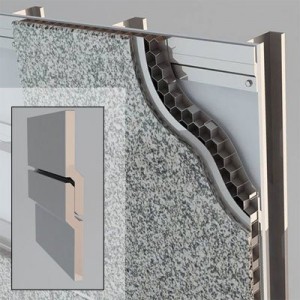Red Sandstone Exterior Cladding NASA Johnson Space Center Building 21, Houston, TX Reminiscent of an Southwestern Desert skyline, Red Sandstone can be found all over the world in desert and dry areas. Colored by Iron oxide, Red Sandstone has a neutral warm red color. Red sandstone makes for great exterior cladding due to […]
Atlantis: The Cove
The Largest Stone Clad building in the Caribbean meets the challenges of fast track schedule and hurricane proof construction
The Cove, a $1 billion expansion to Atlantis, includes resort hotels, restaurants, condos and retail. The upmarket resorts modern and refined architecture and simple architectural forms required cladding that was elegant, durable and beautiful. The owner and architects selected StonePly. Use of the natural stone faced StonePly panels allowed for sophisticated and refined detailing on the interior and exterior stonework.
To build the resort, the cladding faced several challenges:
- The spectacular island location surrounded by tropical beaches limited site access and space.
- The ocean front location required a cladding that could stand up to extreme hurricane force winds, salt spray and tropical sun.
- The resorts fast track schedule allowed just 90 days from approval to quarry, cut, fabricate, ship and install 120,000 square feet of stone cladding.
- Ease of installation. The Islands have a limited workforce and the cladding had to be able to be installed to an extremely high level of quality by average laborers without previous cladding experience.
The Challenges: Beauty, Hurricanes, Fast Schedule and Size
Did the building create any challenges during the erection of the stone? Nothing that couldn’t be solved by simple connection details and StonePly panels. “Due to the constraints of performance, time and budget we used StonePly,” sums up John Newbold, who was the contractors lead on the project, “StonePly let us meet the key challenges we faced. StonePly offered a much better choice than slab stone in terms of economics, schedule and strength.”
“Cladding a building the size of the Atlantis Cove in slab stone would have exceeded the capacity of any installer and the installation would have taken months. With StonePly the stone panels arrived on time and the installers did not need to be highly skilled stone setters, basic carpentry skills were all that was needed.”
Mock-ups Aid Designers
For the stone cladding, the designers selected a combination of a grooved finish with saw marks and a contrasting hammered finish. To ensure the designers got the look they wanted, StonePly first produced numerous stone samples for the architect to select from. Once a stone was selected, they proceeded to larger, full size samples. Once those were approved, StonePly created a full size mock-up of the panels to review color, texture and attachment details. “The mock up assured the team that StonePly could provide the look they all wanted,” Newbold said.
Simplified Connections
Structural support for the StonePly panels was much simpler than it would have been with slab stone cladding. “With slabs, we would have needed a complex support structure to carry the weight and to counter the brittle nature of slabs,” he notes. With StonePly, a lightweight aluminum frame was used with z clips to quickly fasten the panels.
StonePly Helps with Tight Site
With construction taking place on an island, space was limited. And since some of the work took place over the water, access was difficult. The use of StonePly minimized the construction time and the space required for installation. Several hundred square feet of the thin, lightweight panels fit on a pallet and the individual panels could be easily moved by hand. One or two men on a boom or a scaffold could install the panels. “A typical 4’ by 4’ slab that would have weighed 640 lbs. in slab stone weighed just 56 lbs. in StonePly. That translates into a huge difference in speed, logistics, space required, structural support and productivity.” Newbold said.
Panels Easily Pass Hurricane Testing
One of the early concerns with the project was the hurricane force winds that strike the islands on occasion. A series of tests were performed to verify the strength of the panels and connections.
- Large Missile Impact StonePly panels were tested and easily passed the large missile impact test. This involved repeatedly firing a weighted 2” by 4” by 8’ board at the panels. When subjected to the same test, ordinary stone slabs would shatter.
- Wind Suction The panels and connections were field tested for suction up to 4 times the hurricane force winds (the testing equipment limits). In the laboratory the panels were tested to 50 times hurricane loads.
- Additional testing In addition, the panels passed rigorous testing for flexural strength, adhesive strength, UV exposure, expansion/contraction and impact. “They have been soaked in salt water, had a 2 by 4 fired at them, subjected to hurricane winds, been sprayed, bent, heated, beaten and crushed. They are probably the most tested stone panels ever made,” said Newbold.
Speed: A major benefit
To meet the time frame required by Kerzner, The Cove was built on a fast-track schedule, with construction beginning before the final design was complete. The StonePly production capacity was a key reason they were selected. With only 90 days from approvals to produce and install 120,000 square feet of stone cladding, schedule was a key concern. “Even with the fast track schedule, the resort opened on time. That would simply not have been possible with conventional stone slab cladding”.
Visit StonePly to see more projects, technical data and details.



No comments yet.